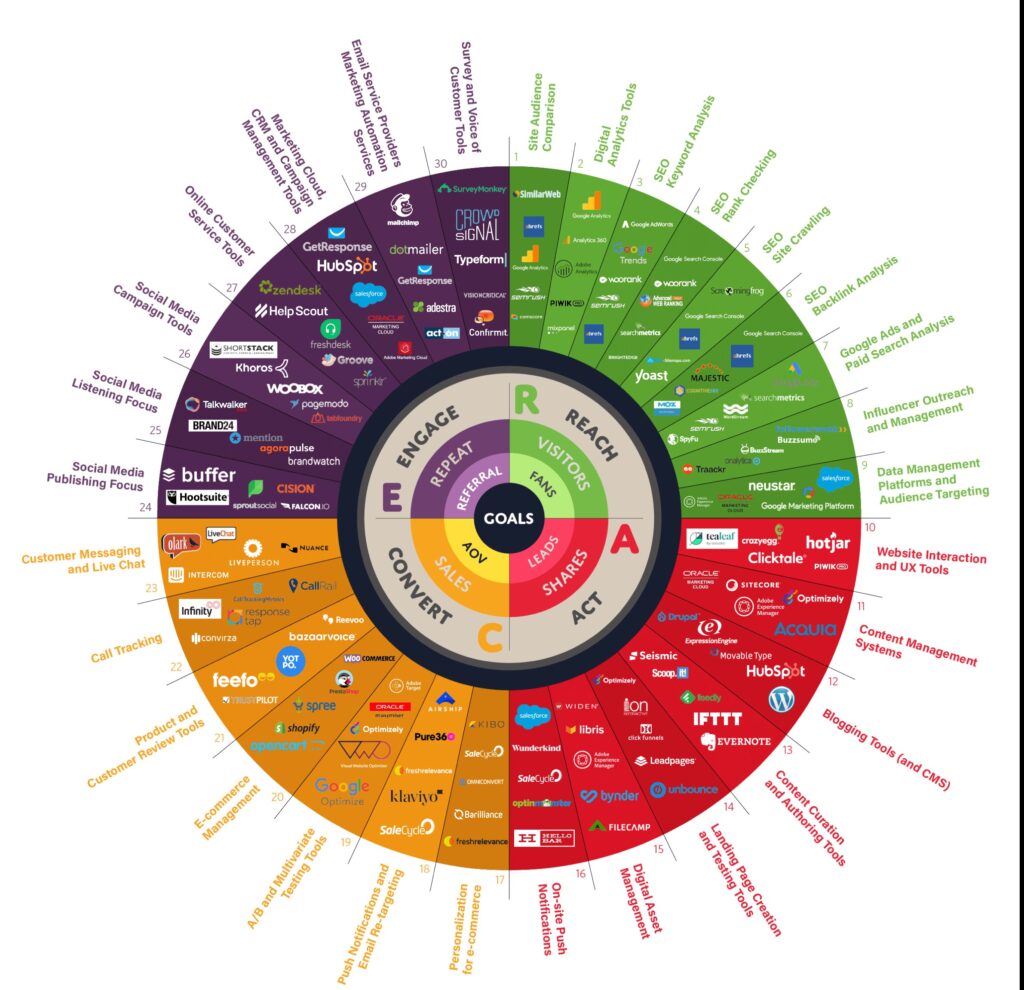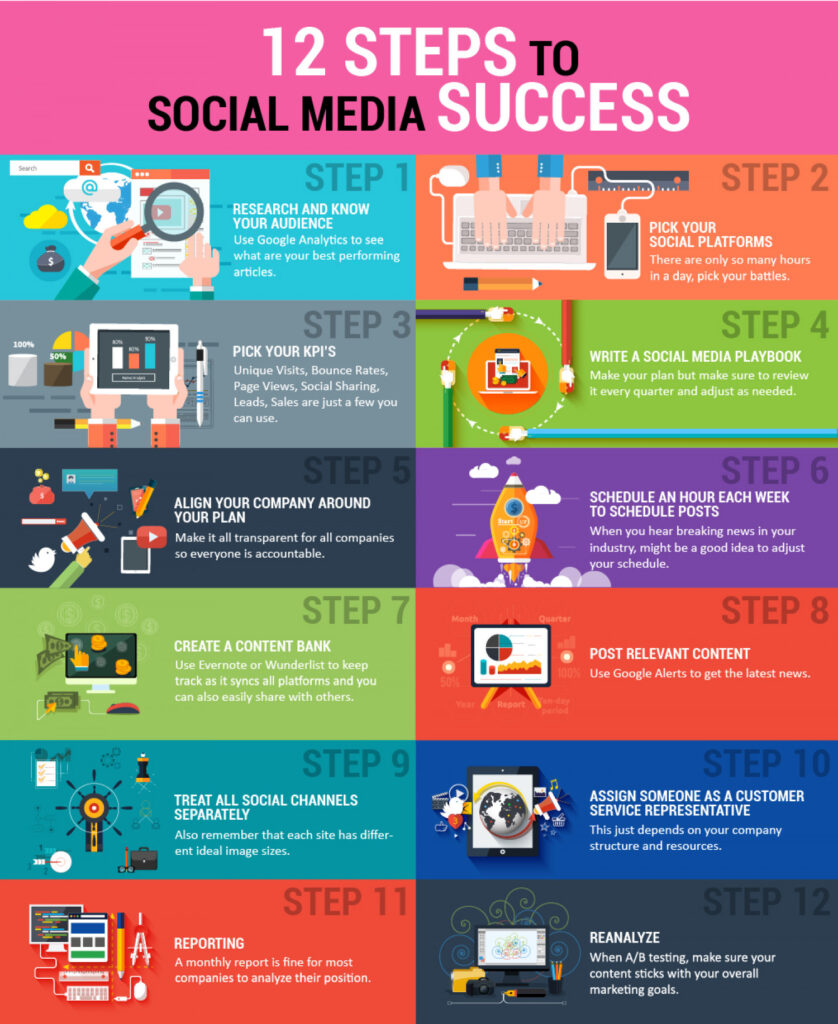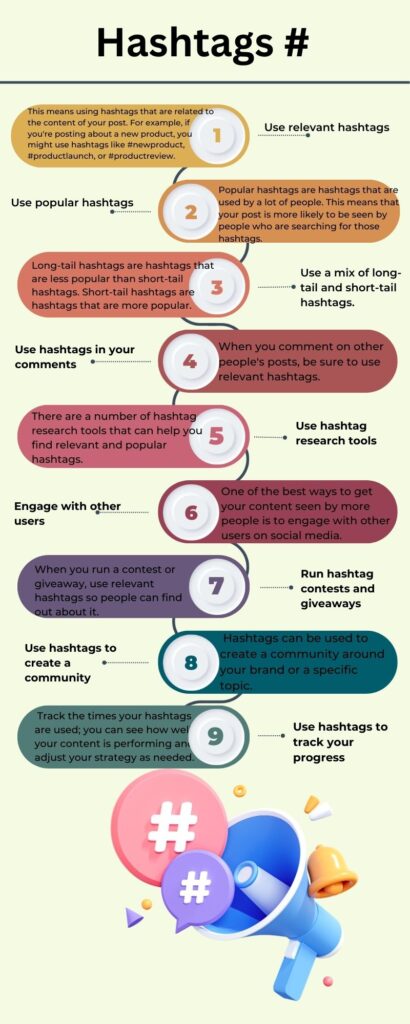Unleashing the Power of Social Media: Strategies for Dominating Your Digital Landscape

Statista estimates that about 4.41 billion people use social media globally; in the US alone, an astounding 82% of the population utilizes social media. These enormous numbers might result in fantastic marketing ambassadors for your company.
Social media is a potent tool to boost sales, build brand recognition, draw in and interact with consumers, and generate leads; the prospects to grow your company are vast.
Your best method is social media.
Social media has evolved into your company’s “do it all” strategy. It is ideal for spreading your message and comprehending the demands and complaints of your target audience. You can’t simply announce something and expect no feedback, even if it is a great way to get to know your audience well. Gaining consumers’ confidence is social media’s main goal to convert them into devoted patrons and champions. The easiest approach to do this is to make the most of social media platforms by developing a thorough marketing strategy to grab consumers’ attention. To produce measurable results that can be quantified is the main goal.
The Best Social Media Strategy
Understanding your target market’s behavior can help you contact them effectively and eventually enlist them in your tribal brand. This requires time and work, particularly if you are gaining marketing knowledge while advertising your business. Keep in mind that you are working on two projects at once, which will take longer than employing a professional marketing firm. The benefit of doing it yourself is gaining new skills and making some financial savings. Nevertheless, the lack of knowledge, focused techniques, and—most importantly—specialized programs that can accelerate your progress might be irritating.
Understanding the Social Media Landscape: Key Platforms and Trends

New platforms and trends emerge in social media. To reach your target audience, you must grasp the significant platforms and trends which might be hard to stay up with.
2023 social media platforms and trends include:
- Video: Platforms like TikTok and YouTube have grown rapidly in popularity. Engaging and instructive videos will help social media businesses prosper.
- Livestreaming is another social media trend. Live broadcasting lets businesses address queries in real time.
- Instagram, Snapchat, and Facebook use stories. Stories are 24-hour postings. Businesses may use stories to provide behind-the-scenes material, advertise new items, or host competitions and giveaways.
- Influencer marketing: Businesses often use influencer marketing to reach more people. Social media influencers have big followings. Businesses may reach their target audience and authentically advertise their goods and services by working with influencers.
- Social commerce: Social media allows direct product sales. Social commerce simplifies client purchases.
These are some 2023 social media sites and trends to watch. These trends help firms reach their target audience and prosper.
Social networking tips:
High-quality, engaging material is the key to social media success. Blog entries, infographics, videos, and images are examples.
Consistently publish on social media to establish a following. Post daily, if feasible.
Engage with your audience. Like, comment, and reply to audience postings.
Use social media analytics: Most social media networks include analytics tools to measure progress and content performance. Use these tools to determine what’s working and what’s not, then alter your plan.
Follow these social media tactics to reach your target audience and develop your company.
Defining Your Social Media Objectives: Setting the Stage for Success
Clear social media goals are essential. This will aid your attention and development. Social media goal-setting tips:
- Business objectives first. What are your social media goals? Want more leads, sales, or brand awareness? Once you know your company goals, you may set social media goals to accomplish them.
Be precise. Don’t mention “increase brand awareness.” Instead, aim to “increase website traffic by 10% in three months.” - Measure it. To measure your social media growth, set quantifiable goals. Tracking monthly unique visitors is one way to measure website traffic.
- Be practical. Set achievable objectives. Start with simple, attainable objectives and raise them as you succeed.
- Be timely. Set a social media goal deadline. This keeps you on target and ensures growth.
These guidelines will help you set clear and precise social media goals to meet your company goals.
Social media goals:
10% brand awareness in three months.
100 leads in 6 months.
Sell $10,000 in 9 months.
You may create a social media plan after defining your goals. This plan should include:
What will you post on social media? Blogs, infographics, videos, or anything else?
What’s your social media posting schedule?
Which social media channels will you use?
Measurement: How will you monitor and evaluate your social media strategy?
Following these steps, you may set precise social media goals and create a plan to achieve them. This helps you expand your company using social media.

Knowing Your Audience: Deep Dive into Demographics and Behaviors
Successful businesses must know their audience. Understanding your audience helps you generate compelling content and sell your goods or services in a manner that resonates with them.
Knowing your audience involves demographics and habits. Audience demographics include age, gender, geography, income, and education. Behaviors include what your audience reads, buys, and does on your website or app.
There are several approaches to learning about your audience’s demographics and behavior. Conduct surveys, interviews, or focus groups. Your website or app’s traffic, bounce, and conversion statistics may be analyzed.
You can produce compelling content by researching your audience demographics and habits. This data may help you advertise to them.
Examples of using demographic and behavioral data to better marketing:
- Create material for ladies if your audience is primarily female.
- TikTok and Instagram may reach young adults.
- Run adverts in a city where your audience is concentrated.
- Create material linked to your audience’s main interest.
Understanding your target demographics and habits may help you design a more successful marketing plan and achieve your company objectives.
Additional audience-understanding tips:
- Talk to customers. Talking to your audience is better. Ask them what they enjoy and hate about your company and what they want more of and less of.
- Track website traffic. Check your visitors’ origins, pages, and duration. This data reveals your audience’s preferences.
- Analyze social media. Facebook and Twitter provide analytics tools to measure audience demographics, interests, and activities. This data may help target content and marketing activities.
These strategies can help you understand your audience and enhance your marketing.
Crafting a Winning Content Strategy: Engaging, Valuable, and Shareable
Engaging, useful, and shareable information wins. Create material that your audience will like and share.
Content strategy tips:
- Know your audience. Understand your audience before developing compelling content. Their hobbies? Their needs? What hurts? Understand your audience to develop relevant content.
- Be inventive. Create compelling content in numerous ways. Write blog entries, make infographics, record movies, or share intriguing articles or photographs. Creativity and novel material presentation are crucial.
- Inform others. Content should be informative and entertaining. Your audience needs useful information. Tips, guidance, or fascinating information.
- Be shareable. Make your material shareable to succeed. Make it simple for your audience to share your material on social media or with friends and coworkers. You may achieve this by adding social sharing buttons or producing aesthetically engaging shareable content.
These strategies will help you create an engaging, informative, and inspiring content strategy.
Engaging content tips:
- Visualize well. Visual content engages more. Highlight your information with high-quality photos, videos, and infographics.
- Tell tales. People adore tales. Storytelling engages and makes material memorable.
- Be unique—people, not brands, bond. Write about yourself and your experiences.
- Be prompt. Timely, relevant material engages people more.
Use current events and trends to produce engaging content.

Captivating Visuals: Elevating Your Brand with Compelling Imagery
Using captivating images is a strong way to make your brand stand out. If you use them right, they can help you:
Attract attention: In a world where information is always coming at us, it’s more important than ever to stand out. Using pictures that are interesting can help you do just that.
Build trust: When people see that you took the time to make good pictures, they are more likely to trust your brand.
Create a good image: Visuals can help you make a good impression on possible customers about your brand.
Drive sales: If you use eye-catching images well, they can help you drive sales and make more money.
If you want to make your brand more appealing with pictures, try these:
Use good pictures. The quality of your images is very important. Use clear, well-lit photos with a high quality.
Keep your visuals in line with your brand. Your visuals should look and feel like your business as a whole. This means that your images should all use the same colors, fonts, and styles.
Use pictures that tell a story. Pictures can be a strong way to tell a story about your brand. Use them to show people what you do, who you are, and what you stand for.
Use pictures that your viewers can relate to: Your pictures should be useful to the people you want to reach. This means you should use pictures that they will find interesting and catch their attention.
People are more likely to share images that they find interesting and engaging. Add social media sharing buttons to your website or blog to make your images easy to share.
By using these tips, you can make your brand stand out and reach your business goals with the help of eye-catching images.
Here are some names that make great use of eye-catching images:
- Apple: Apple is a master at using images to make people feel like their products are expensive and sophisticated. Their website is full of high-quality pictures that show off their goods beautifully.
- Nike: Another brand that does a great job with pictures is Nike. Their ads are usually full of movement and energy and always show players doing well.
- Coca-Cola: Coca-Cola has been selling its product with pictures for decades. Their famous red-and-white logo is easy to remember, and their ads often make people feel nostalgic and happy.
These are just a few names that make great use of eye-catching images. If you want to make your brand stand out, think about putting pictures in your marketing papers.

Driving Engagement: Building a Thriving Community of Followers
Building a strong group of fans requires getting people to interact with you. When people are interested in your content, they are more likely to stick with your brand and buy from you again.
Here are a few tips for driving engagement:
- Create high-quality content: The first step to increasing involvement is to create high-quality content that your audience will find interesting and useful. This could be a blog piece, animation, movie, or even a social media post.
- Be consistent: If you want to gain followers, you need to post regularly. Try to post at least once a day, and if you can, more often.
- Talk to your audience. Don’t just post something and then leave. Take the time to connect with your audience by liking, writing on, and replying to their posts.
- People love free stuff, so holding events and giving things away is a great way to get people interested.
- Use social media analytics. Most social media sites have analytics tools that can help you track your progress and see how your content is doing. Use these tools to find out what’s working and what’s not, and then change your plan based on what you find.
Mastering the Art of Hashtags: Boosting Discoverability and Engagement
Hashtags enhance social media discoverability and engagement. They may help you connect with like-minded individuals and expand your audience.
Here are a few tips for mastering the art of hashtags:
- Use relevant hashtags: Relevant hashtags are the most crucial hashtagging guideline. This involves employing hashtags relevant to your message. Use #newproduct, #productlaunch, or #productreview to post about a new product.
- Use popular hashtags: In addition to using relevant hashtags, you should also use popular hashtags. Popular hashtags are hashtags that are used by a lot of people. This means that your post is more likely to be seen by people who are searching for those hashtags.
- Use a mix of long-tail and short-tail hashtags: Long-tail hashtags are hashtags that are less popular than short-tail hashtags. However, they also tend to be more specific. This means that your post is more likely to be seen by people who are specifically interested in the topic of your post. Short-tail hashtags are hashtags that are more popular than long-tail hashtags. However, they also tend to be more general. This means that your post is more likely to be seen by a wider audience.
- Don’t use too many hashtags: Avoid overusing hashtags: It might be tempting to use as many hashtags as you can, but doing so may reduce your visibility. There is a limit on the amount of hashtags you may use on social media networks, and adding too many might make your post seem spammy.
- Update your hashtags regularly: Hashtags can become outdated over time, so it’s important to update your hashtags regularly. This will help you ensure that your post is seen by people who are still interested in the topic.
Here are some additional tips for using hashtags:
- Use hashtags in your bio: Your bio is a great place to use hashtags because it’s one of the first things people see when they visit your profile.
- Use hashtags in your comments: When you comment on other people’s posts, be sure to use relevant hashtags. This is a great way to get your content seen by a wider audience.
- Use hashtags in your captions: When you post new content, be sure to use relevant hashtags in the caption. This is a great way to get your content seen by people who are searching for those hashtags.
- Use hashtag research tools: Use tools for hashtag research Numerous hashtag research tools are available to aid in your search for pertinent and well-liked hashtags. These resources might help you identify fresh hashtags to use in your posts.

Strategic Collaborations: Leveraging Alliances for Mutual Growth
Strategic partnerships between two or more companies are intended to accomplish a single objective. They may be an effective tool for companies of all sizes since they can:
- Expand into new markets: A firm may swiftly and easily enter a new market by collaborating with a company that already has a presence there.
- Create fresh goods and services: Businesses may create new goods and services they couldn’t create by pooling their resources and skills with those of other enterprises.
- Cost savings: Companies may save costs and improve efficiency by pooling resources and knowledge.
- Enhance customer service: By collaborating, organizations may enhance customer service by giving consumers a more seamless experience.
The optimal kind of strategic cooperation for a corporation will rely on its particular requirements and objectives. There are many distinct sorts of strategic partnerships. Typical forms of strategic partnerships include:
- Joint ventures: A joint venture is when two or more firms jointly own a new company.
- Strategic alliances: A strategic alliance is an agreement between two or more businesses to collaborate on a certain project or objective.
- Partnerships: In a partnership, two or more businesses collaborate often.
It’s crucial to weigh a strategic partnership’s advantages and disadvantages thoroughly. The following are some possible advantages of strategic collaborations: - Increased market share: A corporation may enter a new market swiftly and easily by teaming up with a company with a significant presence.
- Cost savings: Companies may save costs and improve efficiency by pooling resources and knowledge.
- Enhanced customer service: By collaborating, organizations may enhance customer service by giving consumers a more seamless experience.
Staying Ahead of the Curve: Embracing Emerging Trends and Innovations
Businesses that wish to remain ahead must embrace new trends and ideas. Tips for keeping ahead:
Industry trends are among the finest ways to remain ahead of the curve. You can read business magazines, attend enterprise events, and follow thought authorities on social media.
- Be open-minded: Even if they’re uncomfortable, try new things. Being open to new ideas is the greatest method to uncover unique solutions.
- Try things: Take chances and experiment. New methods are the only way to discover what works.
- Be flexible: Businesses that wish to remain ahead must adapt to the changing business landscape. Change your goods, services, and company model.
Follow these ideas to keep ahead in the ever-changing work environment.
Here are some examples of rising trends and ideas firms may use to remain ahead:
- AI: Businesses may utilize AI to boost efficiency, productivity, and customer service.
- Machine learning: This AI subset lets computers learn without being trained. Automate activities, find trends, and forecast.
- Big data: Complex, big datasets. Big data helps businesses understand consumer behavior, spot patterns, and improve choices.
- Blockchain: Secure and transparent transaction recording. Blockchain improves supply chain management, tracks payments, and creates tamper-proof records.
- VR and AR: Immersive technology may produce realistic and engaging experiences. VR and AR can teach staff, serve customers, and build marketing campaigns.
These are some upcoming trends and ideas organizations may use to remain ahead. Businesses may employ these technologies to enhance operations and reach their objectives by being open to new ideas and experimenting.
Conclusion
Social media helps companies connect with clients, create connections, and boost revenue. Businesses may control their digital environment by following the techniques in Unleashing the Power of Social Media.
Main Lessons:
Set goals and objectives before utilizing social media. Social media goals? Want more leads, sales, or brand awareness?
Select platforms: Social media platforms vary. Choose platforms that match your target audience and help you reach your objectives.
Develop compelling material: Social media is visual, so develop stuff that will grab attention. Use high-quality photographs and videos, clear subtitles, and relevant hashtags.
Be constant: Social media is long-term. Results and the following take time. Maintain your publishing schedule and content quality.
Measure outcomes to discover what works and what doesn’t. Track your success and alter your plan using social media statistics.


